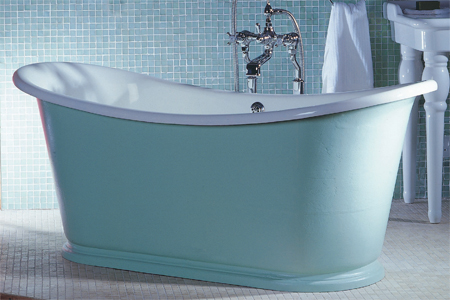
Victurkian Baths
Issue 4 Mar / Apr 2004
A Turkish-Victorian inspired bathroom will be more than just a functional place for washing. It will be a haven for relaxation. Roll top baths and legged sinks can be complemented with Turkish inspired tiling. Jacuzzi baths and steam showers can add to the Turkish bath feel.
The BBC’s highly popular Restoration programme combined reality TV with architectural polemic to give the nation their chance to vote to save a building of national historical significance. And the winner? The Victorian Turkish Baths in Manchester walked away with the £3m Heritage Lottery Fund Grant.
The 300,000 viewers who voted for it were obviously captivated by the still ravishing shell of one of the most opulent public baths ever built. The best definition of the Victorian Turkish Bath is that offered by historian and Victorian Turkish Bath expert, Malcolm Shifrin. He describes it as a type of bath in which the “bather sweats freely in a room which is heated by a continuous flow of hot dry air, followed by a full body wash (sometimes preceded by a cold plunge), then by a massage, and finally by a period of relaxation in a cooling-room.” It is the dryness of the air which distinguishes the Victorian Turkish bath from other related types—the vapor bath, the Russian steam bath, or the Finnish sauna.
For many, the Victorian Turkish Bath is the westernised version of the Hammam which in Arabic means “spreader of warmth”. It was when the Arabs encountered Roman and Greek baths in Syria that they adopted the pleasure of hot air bathing. They were quick to tailor them to their own ways and the hammam gained religious significance and became an annex to the mosque, used to comply with the Islamic laws of hygiene and purification.
In 1850, anything ‘oriental’ was in vogue and bathing caught the attention of Europe. David Urquart, author of the Pillars of Hercules spent much time in Greece and Spain where hammams still enjoyed popularity. He was impressed by their extensive use by the population and included in his writings detailed plans for the construction of a Turkish bath. Urquart was hopeful that a comparable structure could be built in the smoke-blackened towns of the British industrial centres. So he offered a plan to establish 1000 baths for the two million inhabitants of London. It is from this that the notion of a ‘Victorian’ bath emerged, spreading to all parts of Europe. The first one being built in 1856 by Dr Barter at his Hydropathic Establishment in Blarney. Over the decades, about 600 were built in the British Isles alone.
Sake Deen Mohamed, born in Patna India came to Brighton in 1801 and opened a shampooing and vapour bath business, promoting it as a treatment for ailments from asthma to rheumatism. He was soon appointed shampooing surgeon to the Prince of Wales. His treatment involved lying patients down in a steaming herbal bath until they sweated freely and then massaging them. ‘Shampooing’, which Mahomed introduced to England for the first time, meant massaging rather than hairwashing (from the Hindi word champi , “to massage”).
Bookmark this |
|
Add to DIGG |
|
Add to del.icio.us |
|
Stumble this |
|
Share on Facebook |
|
Share this |
|
Send to a Friend |
|
Link to this |
|
Printer Friendly |
|
Print in plain text |
|


Comments
0 Comments